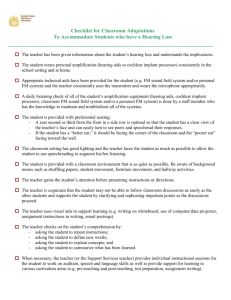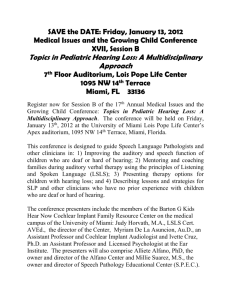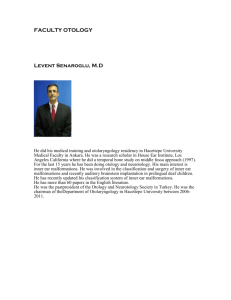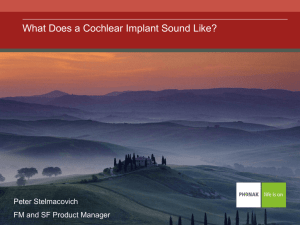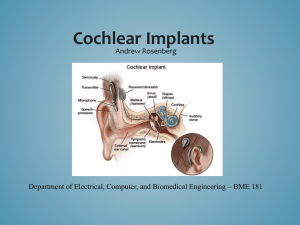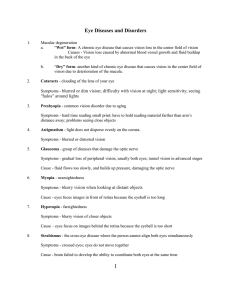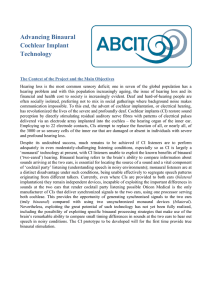Bilateral Cochlear Implants
advertisement
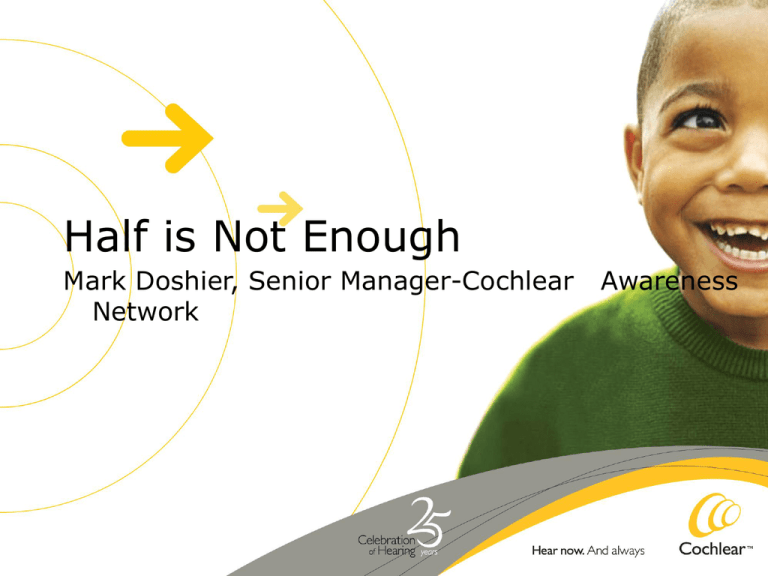
Half is Not Enough Mark Doshier, Senior Manager-Cochlear Network Awareness My Story "I love bilaterals! I cannot stand to wear just one (when I am changing the battery). Only one sounds so wierd now! Wish I had done this a LONG time ago!“—Teri, age 58 Today’s Topics • • • • • Binaural hearing—with 2 ears Adult and pediatric study results Programming Reimbursement Bilateral Recipient Feedback Cochlear’s Philosophy Cochlear believes everyone should have access to the most natural hearing possible. This means that binaural hearing is best practice. How Hearing Works “Since my children received their second implants, they do not have to work so hard to listen. I've had to give up on getting them to take a nap. They now have more energy to play.” Binaural Hearing Animation Why Bilateral Implantation? • Provide benefits of binaural hearing to individuals who receive limited benefit from acoustic amplification • Published studies indicate main benefits to be improved understanding in noise and sound localization Litovsky R, Parkinson A, Arcaroli J, and Sammeth C. Simultaneous bilateral cochlear implantation in adults: a multi-center clinical study. Ear and Hearing (in press). Adult Study Conclusions • Subjects demonstrated improvements in speech understanding in noise The largest benefit is from head shadow effect, listening using ear with better SNR • Subjects demonstrated better speech understanding in quiet Always capture better ear Binaural redundancy • Subjects report improvements in performance with 2 cochlear implants (APHAB) Pediatric Study Conclusions • Improved understanding of speech in quiet environments • Improved understanding of speech in noisy environments • Improved ability to localize sound Pediatric Speech Perception MLNT Words - 3 to 5 Years N=6 N=7 N=7 N=10 N=6 N=9 N=8* N=13 100 100 90 90 90 80 80 80 70 60 50 40 30 Percent Correct 100 Percent Correct Percent Correct N=7 LNT Words - 8 to 13 Years LNT Words - 5 to 8 Years 70 60 50 40 30 60 50 40 30 20 20 10 10 10 0 Preoperative 1st Side Only Bilateral 2nd Side Only 3 Months 6 Months 12 Months Test Interval 0 Preoperative 1st Side Only Bilateral 2nd Side Only 3 Months 6 Months 12 Months Test Interval * One subject at 9 months Preoperative 1st Side Only Bilateral 2nd Side Only 6 Months Test Interval Word recognition for older children improves compared with preoperatively with a hearing aid, but gap between Gap between 1st ear (green) and 2 ear (blue) closes over 6 to 12 months for younger children (3 to 5 yrs and 5 to 8 yrs Cochlear Pediatric Sequential Study N=12 70 20 0 N=13 1st and 2nd ear does not close as with younger children. 12 Months Pediatric Candidacy • Consider for children who do not benefit from amplification in the contralateral ear • For children with usable residual hearing in contralateral ear, a hearing aid trial should be conducted prior to consideration of a 2nd implant Moog School Survey • Parent survey of 20 bilateral children Take away message: All participants would recommend bilaterals to other parents What Parents Say Top reasons parents gave for choosing a 2nd CI: • Improved localization • Improved comprehension • Child expressed desire • For easier communication • Hear better in noise • Progressive loss in hearing aid ear • Hoping for faster rate of progress • Back-up if one implant fails 2006 Moog School Parent Survey What Bilateral Kids Say Feedback from children (8+) •“Now I can hear in both ears” •“It’s not hard to get used to or take care of” •“It’s easier to hear what people say to me” •“If you’re playing hide & seek, you know which way to go” •“I like that people won’t worry what side [of me] to sit on” 2006 Moog School Survey Nucleus® and Bilaterals • Reliability is twice as important for bilateral patients— Nucleus® leads industry in reliability of internal implant— generation after generation • Best hearing performance—Nucleus Freedom™ clinical trial revealed a new benchmark in hearing performance • Lifetime Commitment—only Cochlear has a track record of providing all of our recipients the opportunity to continually upgrade to new technology • Programming software designed to maximize performance for bilateral recipients Reimbursement Considerations "Music sounds so much richer and fuller; I'm definitely getting much more appreciation of music with two implants"- Lexi, age 41 Obtaining Coverage Points to consider: • Combination of medical, educational, behavioral and legal arguments • Medical necessity • Family and provider persistence: key to exceptions • Coordinated efforts among clinician and family/patient Obtaining Coverage • A preponderance of literature regarding advantage of binaural hearing • Always mention first implant • Payers seem to cover children more readily than adults • Performance: Improved localization and in noise • Bilaterals not “experimental” function Cochlear’s Insurance Support Since 1988, OMS Insurance Support has been a resource for professionals and consumers • Preauthorization services • Verification of insurance coverage • Assistance with appeals process if denied coverage • Vaccination programs • Warranty programs Cochlear’s OMS OMS Insurance Support services provided free of charge; contact us at: 1-800-633-4667 Or http://www.omsinsurancesupport.org/ Summary A Fast Growing Trend • There are over 4000 Nucleus® bilateral cochlear implant recipients worldwide The Bilateral Difference Having a cochlear implant on both sides can make a difference; there is the potential to: • Hear with greater ease in more places • Understand better in noisy situations • Know where sound comes from without looking • Greater ease of overall communication Thank you… Any questions? How a CI Works 1. Sound processor captures sound & converts to digital signals 2. Processor sends signals to internal implant 3. Implant converts signals into electrical energy, sending it to electrode array in cochlea 4. Electrodes stimulate hearing nerve and brain perceives signals
